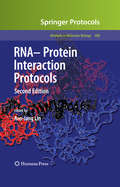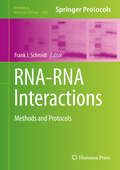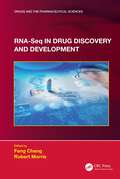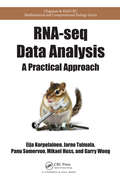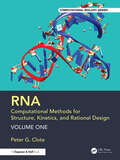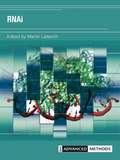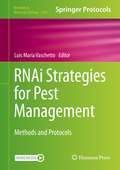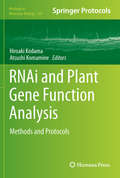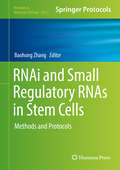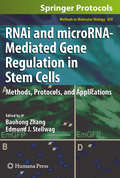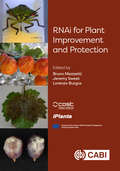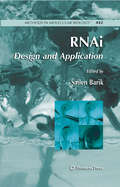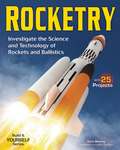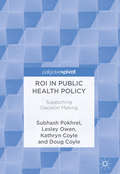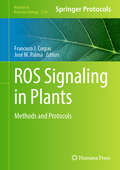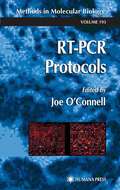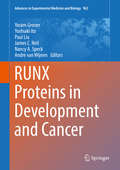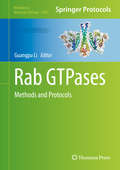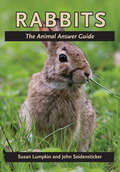- Table View
- List View
RNA-Protein Interaction Protocols
by Ren-Jang LinDue to the vital biological importance of RNA and proteins functioning together within a cell, a protocol volume describing experimental procedures to study their interactions should find a home in many laboratories. RNA-Protein Interaction Protocols, Second Edition updates, complements, and expands upon the popular first edition by providing a collection of cutting-edge techniques developed or refined in the past few years along with tried-and-true methods. The expert contributors explore the isolation and characterization of RNA-protein complexes, the analysis and measurement of RNA-protein interaction, and related novel techniques and strategies. Written in the highly successful Methods in Molecular BiologyTM series format, the chapters include brief introductions to the material, lists of necessary materials and reagents, step-by-step, readily reproducible laboratory protocols, and a Notes section which highlights tips on troubleshooting and avoiding known pitfalls. Comprehensive and up-to-date, RNA-Protein Interaction Protocols, Second Edition is an ideal guide for researchers continuing the study of this all-important biological partnership.
RNA-RNA Interactions
by Frank J. SchmidtIn this volume expert researchers in the field detail many of the methods which are now commonly used to study RNA. These methods are presented as a guidebook to scientists who are experienced with RNA research and want to brush up on a new technique. Written in the highly successful Methods in Molecular Biology series format, chapters include introductions to their respective topics, lists of the necessary materials and reagents, step-by-step, readily reproducible laboratory protocols, and key tips on troubleshooting and avoiding known pitfalls. Thorough and intuitive, RNA-RNA Interactions: Methods and Protocols guides scientists investigating biological systems and studying RNA.
RNA-Seq in Drug Discovery and Development (Drugs and the Pharmaceutical Sciences)
by Feng ChengThe research and development process in modern drug discovery and development is a complex and challenging task. Using traditional biological test methods such as PCR to measure the expression levels or function of these genes is costly and time-consuming. RNA-seq can measure the expression patterns of thousands of genes simultaneously and provide insights into functional pathways or regulations in biological processes, which has revolutionized the way biological scientists examine gene functions. This book addresses the various aspects of the RNA-seq technique, especially its application in drug discovery and development. Features • One of the few books that focuses on the applications of the RNA-seq technique in drug discovery and development • Comprehensive and timely publication which relates RNA sequencing to drug targets, mechanisms of action, and resistance • The editor has extensive experience in the field of computational medicinal chemistry, computational biophysics, and bioinformatics • Chapter authors are at the frontline of the academic and industrial science in this particular area of RNA sequencing
RNA-seq Data Analysis: A Practical Approach (Chapman & Hall/CRC Computational Biology Series)
by Eija Korpelainen Jarno Tuimala Panu Somervuo Mikael Huss Garry WongThe State of the Art in Transcriptome AnalysisRNA sequencing (RNA-seq) data offers unprecedented information about the transcriptome, but harnessing this information with bioinformatics tools is typically a bottleneck. RNA-seq Data Analysis: A Practical Approach enables researchers to examine differential expression at gene, exon, and transcript le
RNA: Computational Methods for Structure, Kinetics, and Rational Design: Volume One (Chapman & Hall/CRC Computational Biology Series)
by Peter G. CloteComprising two volumes, RNA: Computational Methods for Structure, Kinetics, and Rational Design is a comprehensive treatment of computational methods concerning the secondary structure, folding kinetics and rational design of RNA.Volume One concerns energy and structure and is divided into five chapters. Chapter 1 describes the molecular structure of ribonucleotides, basic classes of RNA and databases of RNA sequences and structure. Chapter 2 presents the basic concepts of thermodynamics, since thermodynamics-based algorithms constitute an essential tool in rational design of functional RNA molecules. Chapter 3 describes how empirical secondary structure energy parameters are obtained from ultraviolet absorbance experiments via Van 't Hoff plots and least-squares data fitting. Chapter 4 describes methods from combinatorics, automata and formal language theory, and complex analysis. Chapter 5 provides an overview of some of the most important thermodynamics-based algorithms related to secondary structure. Exercises and solutions are provided at the end of every chapter and source code is available at the book's website (sometimes including computer programs using Python and extensions Numpy and Scipy).This book provides the nuts, bolts and tools to take the next steps in computational RNA synthetic biology. It is perfect for advanced undergraduate, graduate and post-graduate readers having analytical interests and skills from areas such as physical chemistry, physics, mathematics, computer science, and statistics.
RNAi (Advanced Methods)
by Martin LatterichOne of the major recent discoveries in molecular and cellular biology is that small double-stranded RNA molecules selectively turn off gene expression in all types of cell, a phenomenon known as RNA silencing. This discovery led to the development of RNA interference (known as RNAi) as a powerful research tool in the functional study of individual genes and their products, and in functional genomics. In RNAi, specific small double-stranded RNA molecules (small interfering RNAs or siRNAs) are introduced into cells to selectively silence certain genes. RNAi covers the basic concepts and mechanisms of RNAi, transfection of cells with siRNAs, the design and validation of RNAi reagents, RNAi techniques in different organisms, large-scale RNAi screening, applications of RNAi in drug discovery, and potential uses of RNAi as a therapeutic agent. A key feature of RNAi is the highlighting of the pitfalls that can occur and how to minimize them. The book also contains a complete list of abbreviations.
RNAi Strategies for Pest Management: Methods and Protocols (Methods in Molecular Biology #2360)
by Luis María VaschettoThis volume explores the latest techniques used for sustainable development of eco-friendly pest management systems. Chapters in this book look at the design of novel RNAi-mediated pest control strategies and related issues. Some of the topics covered in this book are identification and characterization of differentially expressed non-coding RNAs in insect genomes; functional small RNA design; analysis of endogenous RNAi pathways; RNAi screening; plant models of RNAi-mediated pest control; and dsRNA delivery. Written in the highly successful Methods in Molecular Biology series format, chapters include introductions to their respective topics, lists of the necessary materials and reagents, step-by-step, readily reproducible laboratory protocols, and tips on troubleshooting and avoiding known pitfalls. Cutting-edge and comprehensive, RNAi Strategies for Pest Management: Methods and Protocols is a valuable resource for any scientist or researcher interested in learning more about this exciting and developing field. Chapter 18 is available open access under a Creative Commons Attribution 4.0 International License via link.springer.com.
RNAi and Plant Gene Function Analysis
by Atsushi Komamine Hiroaki KodamaThe use of RNAi technology is essential for most plant science researchers. As DNA sequence information increases, so the need for functional annotation of target genes also increases. Authoritative and accessible, RNAi and Plant Gene Function Analysis: Methods and Protocols seeks to serve as an ideal guide to scientists of all backgrounds looking to further their knowledge of this fundamental science. Written in the highly successful Methods in Molecular BiologyTM series format, chapters contain introductions to their respective topics, lists of the necessary materials and reagents, step-by-step, readily reproducible laboratory protocols, and notes on troubleshooting and avoiding known pitfalls. In addition to the functional annotation of unknown genes, RNAi technology has been applied to the genetic engineering of important plant metabolites including starches, oils, and storage proteins. RNAi has been used to engineer plants resistant to plant viruses and also to nematodes and insects. RNAi and Plant Gene Function Analysis: Methods and Protocols will provide both professionals and novices of plant biotechnology and breeding research with essential tips for designing experiments meant to explore plant gene function.
RNAi and Small Regulatory RNAs in Stem Cells
by Baohong ZhangThis detailed collection provides an accessible compendium of up-to-date methods focused on the study of RNAi and small regulatory miRNAs in stem cells. Beginning with a brief introductory section, the volume continues by exploring methods and protocols for RNAi screening, transfection, and the knockdown of specific genes and pathways in several animal species, including humans and mice, recently developed methods for miRNA expression and functional analysis, as well as usage of CRISPR/Cas 9 to knockout an individual gene for functional studies. Written for the highly successful Methods in Molecular Biology series, chapters include introductions to their respective topics, list of the necessary materials and reagents, step-by-step, readily reproducible laboratory protocols, and tips on troubleshooting and avoiding known pitfalls. Practical and authoritative, RNAi and Small Regulatory RNAs in Stem Cells: Methods and Protocols aims to accelerate progress in this crucial field by reducing the time required to decipher and put into practice procedures published in the literature.
RNAi and microRNA-Mediated Gene Regulation in Stem Cells
by Baohong Zhang Edmund J. StellwagRecent stem cell research has revealed that miRNA and RNAi-mediated gene regulation is one of the vital determinates controlling the state of cell differentiation, with the small RNAs serving as key elements involved in regulatory network control of pluripotent cell fate determination. In RNAi and microRNA-Mediated Gene Regulation in Stem Cells: Methods, Protocols, and Applications, expert authors from laboratories across the globe contribute an accessible compendium of up-to-date, proven methods focused on the study of the titular topic. Divided into three sections, the book first gives a brief introduction to RNAi and miRNAs in stem cells, with a focus on the current status of research and future perspectives, then it continues with detailed methods and protocols for RNAi screening, transfection, and the knockdown of specific genes and pathways in several animal species, including humans and mice, concluding with a section on recently developed methods for identification of miRNAs, including a general protocol for preparation and analysis of miRNA libraries for deep sequencing, knock down of a specific gene using miRNA-based shRNA, and miRNA expression analysis using qRT-PCR. Written in the highly successful Methods in Molecular BiologyTM series format, chapters contain introductions to their respective topics, lists of the necessary materials and reagents, step-by-step, readily reproducible laboratory protocols, and notes highlighting tips on troubleshooting and avoiding known pitfalls. Authoritative and cutting-edge, RNAi and microRNA-Mediated Gene Regulation in Stem Cells: Methods, Protocols, and Applications serves as a valuable resource for scientists and aspiring graduate students interested in the intersection of RNAi, miRNA, and stem cell molecular biology and the exciting areas of medicine, including regenerative medicine, aging, cancer, and neurological disorders, that can be advanced through this expanding area of research.
RNAi for Plant Improvement and Protection
by Bruno Mezzetti, Jeremy Sweet & Lorenzo BurgosRNA interference (RNAi) has the potential to make major contributions towards sustainable crop production and protection with minimal environmental impacts compared to other technologies. RNAi is being developed and exploited both within plants (i.e. host-induced gene silencing, HIGS) and/or as topical applications (e.g. spray-induced gene silencing, SIGS) for targeting pest and pathogen genes and for manipulating endogenous gene expression in plants. Chapters by international experts review current knowledge on RNAi, methods for developing RNAi systems in GM plants and applications for crop improvement, crop production and crop protection. Chapters examine both endogenous systems in GM plants and exogenous systems where interfering RNAs are applied to target plants, pests and pathogens. The biosafety of these different systems is examined and methods for risk assessment for food, feed and environmental safety are discussed. Finally, aspects of the regulation of technologies exploiting RNAi and the socio-economic impacts of RNAi technologies are discussed.
RNAi: Design and Application
by Sailen BarikRNA interference (RNAi) is the most recent discovery to revolutionize the study of biology. In this book, leaders in the field contribute state-of-the-art, easy to follow methods and bench protocols designed for practical, everyday use of RNAi in biological research. Cutting edge and clearly written, this book enables a researcher with standard molecular biological training to perform major RNAi-related experiments and contribute to this revolutionary, growing field.
ROCKETRY
by Carla Mooney Caitlin DenhamDo you ever wonder how rockets soar into space? Rocketry: Investigate the Science and Technology of Rockets and Ballistics introduces students to the fascinating world of rocketry and ballistics. Readers discover the history of rocket development, from the earliest fire arrows in China to modern-day space shuttles, as well as the main concepts of rocketry, including how rockets are launched, move through the atmosphere, and return to earth safely. Exploring the science behind rocket flight, kids learn how the forces of thrust, gravity, lift, and drag interact to determine a rocket's path, then imagine new uses and technologies in rocketry that are being developed today and for the future.Combining hands-on activities with physics, chemistry, and mathematics, Rocketry brings fun to learning about the world of rocket science. Entertaining illustrations and fascinating sidebars illuminate the topic and bring it to life, while Words to Know highlighted and defined within the text reinforce new vocabulary.Projects include building a pneumatic blast rocket and launcher, determining the role of fins in rocket stability, testing a rocket recovery system, and designing a rocket model of the future. Additional materials include a glossary, and a list of current reference works, websites, and Internet resources.
ROI in Public Health Policy
by Subhash Pokhrel Lesley Owen Kathryn Coyle Doug CoyleThe demand for return in investment (ROI) analyses in public health is on the rise as a ‘business case’ needs to be presented before a public health programme can be funded. This book explains the science behind ROI analyses and shows how policy makers can learn the art of understanding and using it in the context of public health. Using examples drawn from the NICE ROI Tools, business cases for various alternative policy options around smoking cessation, improving physical activity and reducing alcohol use are presented. In addition, several examples of real-world decision problems facing public health investors are discussed to address the usefulness of ROI evidence in public health policy making.
ROS Signaling in Plants: Methods and Protocols (Methods in Molecular Biology #2798)
by Francisco J. Corpas José M. PalmaThis detailed volume presents methodologies for studying reactive oxygen species (ROS) metabolism in plant cells, including techniques for detecting different types of ROS such as superoxide radicals, hydrogen peroxide or singlet oxygen, as well as ROS generating systems such as xanthine oxidoreductase. The book provides alternatives to determine malondialdehyde, electrochemical detection approaches for determining total antioxidant capacity (TAC) as well as enzymatic antioxidants, as well as methods for studying non-enzymatic antioxidants and some components of the secondary metabolism. Written for the highly successful Methods in Molecular Biology series, the chapters in this book provide the kind of detailed implementation advice that leads to ideal results in the laboratory. Authoritative and practical, ROS Signaling in Plants: Methods and Protocols serves as an ideal guide for scientists interested in the metabolism of ROS in plant cells.
RT-PCR Protocols
by Joe O’connell Nicola KingA panel of highly regarded molecular biologists and clinical researchers describe in detail their most novel, useful, and interesting RT-PCR applications. Here the newcomer will find readily reproducible protocols for highly sensitive detection and quantification of gene expression, the in situ localization of gene expression in tissue, and the cloning of genes, as well as for analyzing T-cell clones and the differential expression of genes. For the expert seeking to extend the usefulness of RT-PCR, there are user-friendly applications that complement the latest technological advances, including laser-capture microdissection (LCM), real-time and quantitative PCR, microarray technology, cDNA cloning, and antibody engineering.
RUNX Proteins in Development and Cancer
by Yoram Groner Yoshiaki Ito Paul Liu James C. Neil Nancy A. Speck Andre Van WijnenThis volume provides the reader with an overview of the diverse functions of the RUNX family of genes. As highlighted in the introduction and several of the 29 chapters, humans and other mammals have three RUNX genes that are known to play specific roles in blood, bone and neuronal development. However, their evolutionary history has recently been traced back to unicellular organisms and their involvement in many well-known signaling pathways (Wnt, TGFb, Notch, Hippo) is indicative of a more general function in cell biology. Their documented roles in cell fate decisions include control of proliferation, differentiation, survival, senescence and autophagy. The pleiotropic effects of RUNX in development are mirrored in cancer, where RUNX genes can function as oncogenes that collaborate strongly with Myc family oncogenes or as tumour suppressor genes. In the latter role, they display hallmarks of both 'gatekeepers' that modulate p53 responses and 'caretakers' that protect the genome from DNA damage. Several chapters focus on the importance of these genes in leukemia research, where RUNX1 and CBFB are frequently affected by chromosomal translocations that generate fusion oncoproteins, while recent studies suggest wider roles for RUNX modulation in solid cancers. Moreover, RUNX genes are intimately involved in the development and regulation of the immune system, while emerging evidence suggests a role in innate immunity to infectious agents, including HIV. At the biochemical level, the RUNX family can serve as activators or repressors of transcription and as stable mediators of epigenetic memory through mitosis. Not surprisingly, RUNX activity is controlled at multiple levels, this includes miRNAs and a plethora of post-translational modifications. Several chapters highlight the interplay between the three mammalian RUNX genes, where cross-talk and partial functional redundancies are evident. Finally, structural analysis of the RUNX/CBFB interaction has led to the development of small molecule inhibitors that provide exciting new tools to decipher the roles of RUNX in development and as targets for therapy. This volume provides a compendium and reference source that will be of broad interest to cancer researchers, developmental biologists and immunologists.
Rab GTPases
by Guangpu LiThis volume covers the latest technological advances in the characterization of the biosynthesis and functions of Rab GTPases and their regulation by guanine nucleotide exchange factors (GEFs) and GTPase-activating proteins (GAPs). The book consists of 28 chapters and starts with an overview of the Rab GTPase family. The next few chapters describe systematic approaches to the identification and classification of Rabs and Rab GAPs, as well as the detection of Rab isoprenylation and membrane distribution. The last few chapters examine the biochemical and functional properties of individual Rabs in the order of exocytic, recycling and endocytic Rabs. Written in the highly successful Methods of Molecular Biology series format, chapters include introductions to their respective topics, lists of the necessary materials and reagents, step-by-step, readily reproducible laboratory protocols and key tips on troubleshooting and avoiding known pitfalls. Instructive and practical, Rab GTPases: Methods and Protocols approaches each topic with great detail and is a valuable resource for researchers and students interested in the field of Rab GTPases.
Rab GTPases: Methods and Protocols (Methods in Molecular Biology #2293)
by Guangpu Li Nava SegevThis second edition volume expands on the previous edition with a discussion of new research and discoveries in the Rab field. Chapters in this book cover topics such as new information on Rab regulation and localization; interaction; function; and diseases. Written in the highly successful Methods in Molecular Biology series format, chapters include introductions to their respective topics, lists of the necessary materials and reagents, step-by-step, readily reproducible laboratory protocols, and tips on troubleshooting and avoiding known pitfalls. Cutting-edge and comprehensive, Rab GTPases: Methods and Protocols, Second Edition is a valuable resource for scientists working in the fields of Rab and other small GTPases, and beyond.
Rabbit Production
by Nephi Patton Peter Robert Cheeke Steven Lukefahr James McNittThis new edition of Rabbit Production is fully updated throughout. Mainly concerning rabbits bred for meat and fur, it also contains practical information on pet rabbits, show rabbits and rabbits used as laboratory animals. Core topics are covered, including rabbit genetics, reproduction, health and diseases, behaviour, welfare, fur and meat production, rabbit production in developing countries, slaughter and the marketing of rabbit products. Current areas of interest such as animal welfare and coat colour genetics are expanded in the new edition. An important resource for all those involved in rabbit production, this book is also vital reading for students and researchers of animal science and meat production, as well as the keen amateur rabbit enthusiast.
Rabbit Production
by Nephi Patton Peter Robert Cheeke Steven Lukefahr James McnittThis new edition of Rabbit Production is fully updated throughout. Mainly concerning rabbits bred for meat and fur, it also contains practical information on pet rabbits, show rabbits and rabbits used as laboratory animals. Core topics are covered, including rabbit genetics, reproduction, health and diseases, behaviour, welfare, fur and meat production, rabbit production in developing countries, slaughter and the marketing of rabbit products. Current areas of interest such as animal welfare and coat colour genetics are expanded in the new edition. An important resource for all those involved in rabbit production, this book is also vital reading for students and researchers of animal science and meat production, as well as the keen amateur rabbit enthusiast.
Rabbits with Horns and Other Astounding Viruses
by Carl ZimmerViruses are the smallest living things known to science, yet they hold the entire planet in their sway. Rabbits with Horns and Other Astounding Viruses explores the bizarre places viruses dwell, and considers the often unexpected ways they influence our world. From agricultural production and crystal caves to rabbits with horns and cervical cancer, viruses are behind many of the wonders--some fascinating, some frightening--of the natural world, as well as some of our greatest medical challenges. Through his engaging considerations of the tobacco mosaic virus, viruses in ocean algae, and the human papillomavirus, award-winning science writer Carl Zimmer brings us up to speed on the nuances and depth of today's cutting-edge scientific research on virology.
Rabbits: The Animal Answer Guide (The Animal Answer Guides: Q&A for the Curious Naturalist)
by John Seidensticker Susan LumpkinDid you know that there are more than 90 species of rabbits, hares, and pikas, rabbits' little-known cousins? And that new species are still being found? Or that baby rabbits nurse from their mothers only once a day? How about that some people brew medicinal tea from rabbit pellets? Wildlife conservationists Susan Lumpkin and John Seidensticker have all the answers—from the mundane to the unbelievable—about the world’s leaping lagomorphs. To some, rabbits are simply a docile pet for the classroom or home. To others, they are the cute animals munching on clover or the pests plaguing vegetable gardens. Whatever your interest, in Rabbits: The Animal Answer Guide you will discover that they are a more complex group than you might have first imagined. Lumpkin and Seidensticker take these floppy-eared creatures out of the cabbage patch and into the wild, answering 95 frequently asked questions about these familiar and fascinating animals.With informative photographs and an accessible format, Rabbits: The Animal Answer Guide is the one resource you will need to learn about rabbits' anatomy and physiology, evolutionary history, ecology, behavior, and their relationships with humans. Lumpkin and Seidensticker also talk about conservation, because while rabbits may breed like, well, rabbits, several species are among the most endangered animals on Earth.
Rabid: A Cultural History of the World's Most Diabolical Virus
by Monica Murphy Bill WasikA maddened creature, frothing at the mouth, lunges at an innocent victim—and, with a bite, transforms its prey into another raving monster. It’s a scenario that underlies our darkest tales of supernatural horror, but its power derives from a very real virus, a deadly scourge known to mankind from our earliest days. In this fascinating exploration, journalist Bill Wasik and veterinarian Monica Murphy chart four thousand years in the history, science, and cultural mythology of rabies. The most fatal virus known to science, rabies kills nearly 100 percent of its victims once the infection takes root in the brain. A disease that spreads avidly from animals to humans, rabies has served throughout history as a symbol of savage madness, of inhuman possession. And today, its history can help shed light on the wave of emerging diseases, from AIDS to SARS to avian flu, that we now know to originate in animal populations. From Greek myths to zombie flicks, from the laboratory heroics of Louis Pasteur to the contemporary search for a lifesaving treatment, Rabid is a fresh, fascinating, and often wildly entertaining look at one of mankind’s oldest and most fearsome foes. .
Rabid: A Cultural History of the World's Most Diabolical Virus
by Monica Murphy Bill WasikA maddened creature, frothing at the mouth, lunges at an innocent victim--and, with a bite, transforms its prey into another raving monster. It's a scenario that underlies our darkest tales of supernatural horror, but its power derives from a very real virus, a deadly scourge known to mankind from our earliest days. In this fascinating exploration, journalist Bill Wasik and veterinarian Monica Murphy chart four thousand years in the history, science, and cultural mythology of rabies.The most fatal virus known to science, rabies kills nearly 100 percent of its victims once the infection takes root in the brain. A disease that spreads avidly from animals to humans, rabies has served throughout history as a symbol of savage madness, of inhuman possession. And today, its history can help shed light on the wave of emerging diseases, from AIDS to SARS to avian flu, that we now know to originate in animal populations. From Greek myths to zombie flicks, from the laboratory heroics of Louis Pasteur to the contemporary search for a lifesaving treatment, Rabid is a fresh, fascinating, and often wildly entertaining look at one of mankind's oldest and most fearsome foes.
